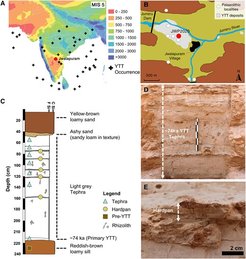New Study Challenges ‘Volcanic Winter’ Theory After Ancient Toba Eruption
New research in India challenges the idea that the Toba super-eruption caused a global volcanic winter. Instead, evidence points to unexpected regional warming.
The eruption of the Toba volcano in northern Sumatra around 74,000 years ago has long been blamed for plunging the planet into a years-long volcanic winter, supposedly pushing human populations to the brink of collapse. But a new study from the Jwalapuram archaeological site in India paints a much more complex—and surprising—picture of what actually happened after the Toba super-eruption.
Instead of global freezing, the international research team lead by Gopesh Jha of the Max Planck Institute of Geoanthropology found signs of a multi-year period of regional warming. Using a combination of advanced techniques—including X-ray fluorescence, stable isotope analysis, and electron microscopy—the team built a high-resolution record of how the environment changed in the wake of the eruption. Their evidence shows progressive weathering of volcanic ash layers and strong evapotranspiration, suggesting that the local climate became hotter and drier, not colder.

The findings challenge the longstanding assumption that the eruption triggered a global environmental catastrophe that bottlenecked human populations. While warming and drying would still have posed major challenges to ecosystems and early human groups, the study suggests near-extinction events were unlikely, at least in South Asia. Instead, the environmental impacts appear to have varied dramatically across different regions.
The researchers also propose that the Toba eruption may have disrupted major climate systems like the El Niño–Southern Oscillation and the Indian summer monsoon, contributing to these unexpected warming trends. By examining subtle chemical and physical changes in the layers of ash, or "tephra," the team was able to piece together an immediate post-eruption climate story that differs sharply from previous models based largely on ice core records and global climate simulations.
Beyond rethinking the Toba event, the study highlights a powerful new approach for investigating ancient volcanic impacts. The researchers argue that similar multi-proxy techniques could be used to study other major eruptions, such as the Campanian Ignimbrite in Europe or the Dawson event in North America, helping scientists better understand how massive volcanic events shape regional climates and ecosystems.












